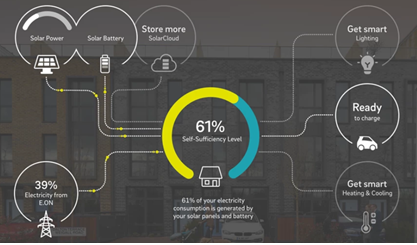- Summary
The Microsoft Azure outage today (19th July of 2024), lasting approximately 5 hours from 5:30 AM to 10:30 AM UTC, had a significant impact across various sectors, including the energy market. This disruption affected cloud services that energy companies rely on for managing operations, data analytics, and real-time monitoring systems. The outage led to delays in energy distribution, hindered monitoring of energy consumption, and created difficulties in managing grid operations effectively, potentially causing a temporary mismatch between energy supply and demand.
Azure is extensively utilized in the electricity market for various key functions. These include predictive maintenance through AI and machine learning to reduce downtime, demand forecasting for optimized energy production, and smart grid solutions for enhanced efficiency and reliability. Companies like Schneider Electric, E.ON, Siemens, and Southern California Edison leverage Azure for these purposes. The outage highlighted the dependency of the energy sector on cloud services and underscored the importance of robust contingency plans to ensure operational continuity and reliability.
- The Azure Microsoft
Azure is Microsoft’s cloud computing platform and service, providing a wide range of cloud services, including computing, analytics, storage, and networking. Users can choose and configure these services to develop and scale new applications or run existing ones in the public cloud.
The Microsoft Azure outage today lasted approximately 5 hours, beginning around 5:30 AM UTC and concluding around 10:30 AM UTC. The disruption affected various Azure services, causing widespread impact across multiple regions and industries, including the energy sector.
The system outage affecting Microsoft’s Azure services this morning (on 19th July 2024) had a notable impact on various sectors, including the energy market. The outage disrupted cloud services, which many energy companies rely on for managing their operations, data analytics, and real-time monitoring systems. This disruption can lead to delays in energy distribution, hindered monitoring of energy consumption, and difficulties in managing grid operations effectively.
In particular, energy companies using Azure for critical applications may have faced operational inefficiencies and communication delays. These issues can cause short-term disruptions in the energy supply chain, potentially leading to a temporary mismatch between energy supply and demand, especially in regions heavily dependent on digital infrastructure for energy management.
- Key Utilizations of Azure in the Electricity Market
Data Analytics and AI:
- Predictive Maintenance: Companies use Azure’s AI and machine learning capabilities to predict equipment failures before they happen, reducing downtime and maintenance costs. For instance, some electricity company leverages Azure to analyze data from its wind turbines and other energy equipment to predict and prevent failures.
- Demand Forecasting: Azure’s data analytics tools help energy companies forecast energy demand more accurately, optimizing energy production and distribution. This improves efficiency and reduces waste, ensuring that supply meets demand without overproducing.
Grid Management:
- Smart Grid Solutions: Azure enables the development of smart grid solutions that enhance the efficiency and reliability of electricity distribution. These solutions use real-time data to monitor and manage the electrical grid dynamically, as seen with Southern California Edison’s Grid Resilience and Intelligence Project (GRIP).
- IoT Integration: Azure IoT services are used to connect and monitor a vast array of devices and sensors across the electrical grid. This integration allows for real-time data collection and analysis, improving grid reliability and response times to outages or anomalies.
Energy Management Systems:
- Energy Optimization: Platforms like Schneider Electric’s EcoStruxure use Azure to collect and analyze data from various sources, helping businesses and utilities optimize energy use and reduce costs. This includes optimizing heating, cooling, and lighting in buildings .
- Renewable Energy Integration: Azure supports the integration of renewable energy sources into the grid. By managing data from solar panels, wind turbines, and other renewable sources, Azure helps balance supply and demand, ensuring a stable and reliable energy supply.
Customer Services:
- Enhanced Customer Experience: Utilities use Azure to provide better customer services through improved data management and analytics. This includes personalized energy usage reports, automated billing systems, and customer engagement platforms, enhancing overall customer satisfaction.
Cybersecurity:
- Security Solutions: Azure provides robust cybersecurity measures to protect the critical infrastructure of energy companies from cyber threats. These measures include advanced threat protection, identity management, and compliance solutions to ensure the security and integrity of energy data and systems.
Overall, Azure’s comprehensive suite of cloud services helps electricity market players improve operational efficiency, enhance customer experiences, and innovate with new technologies, contributing to a more reliable and sustainable energy future.
Overall, while the immediate impacts might be short-lived, such outages highlight the vulnerability of the energy sector to disruptions in cloud services, emphasizing the need for robust contingency plans and diverse infrastructure to ensure reliability.
Several companies in the electricity market utilize Microsoft’s Azure services to enhance their operations. Here are a few examples:
- Schneider Electric: This company leverages Azure for its EcoStruxure[1] platform, which integrates IoT (Schneider, 2024), cloud, analytics, and cybersecurity to deliver innovation at every level, from connected products to edge control and apps, analytics, and services.
- E.ON: One of the largest energy companies in Europe, E. ON uses Azure to improve its energy management systems and customer services, utilizing Azure’s data analytics and AI capabilities to optimize energy distribution and consumption.

Figure 1- E.ON: Smart Home Energy with Solar Power, Source: E.ON webside
- Siemens: Siemens Energy employs Azure to support its cloud-based energy solutions. Their platform, Siemens MindSphere, runs on Azure and provides insights and analytics for optimizing energy production and consumption.
- Southern California Edison (SCE): SCE uses Azure for its Grid Resilience and Intelligence Project (GRIP), which aims to enhance the reliability and efficiency of its electrical grid through advanced data analytics and cloud computing capabilities provided by Azure.
These companies use Azure to improve operational efficiency, enhance customer experiences, and optimize energy management, highlighting the critical role of cloud services in the modern energy sector.
Estimating the financial losses in the electricity market due to a cloud service outage like the one experienced with Microsoft Azure involves several factors, including the scale of reliance on cloud services, the specific operations affected, and the duration of the outage. While specific figures for today’s outage aren’t readily available, we can consider some general factors and previous instances to provide an estimate.
- Factors Affecting Financial Losses
- Operational Disruptions:
- Grid Management: Interruptions in smart grid operations can lead to inefficiencies and potential over or under-supply of electricity.
- Predictive Maintenance: Delays in predictive maintenance can lead to equipment failures, causing unexpected downtime and repair costs.
- Customer Services:
- Billing and CRM Systems: Outages affecting customer relationship management and billing systems can lead to delays in invoicing and customer support, impacting cash flow and customer satisfaction.
- Data Analytics and AI:
- Demand Forecasting: Interruptions in data analytics can affect demand forecasting accuracy, leading to imbalances in energy supply and potential financial penalties for not meeting contractual obligations.
- Scalability and Flexibility:
- Load Management: The inability to scale services during peak demand periods can result in unmet energy demands and potential financial penalties.
- Estimations from Previous Incidents
According to the Previous outages in cloud services have had significant financial impacts. For instance, a major AWS outage in 2017. Even that relatively brief period of downtime cost companies in the S&P 500 index an estimated $150 million (MERTECH, 2024). The Azure outage on 19th July, lasted around 5 hours, we can make a rough estimate by considering the relative scale and dependency on cloud services in the electricity market.
Rough Estimate:
- Electricity Market Scale: The global electricity market is vast, and while not all companies will be equally affected, those heavily reliant on Azure for critical operations will face more significant disruptions.
- Proportional Impact: If we consider that the electricity market’s dependency on cloud services is significant but not as extensive as some other sectors like e-commerce or finance, a rough estimate could place the financial impact in the range of tens of millions of dollars.
Given these factors, it is reasonable to estimate that the financial losses in the electricity market due to the Azure outage could range from $10 million to $50 million. This is a broad estimate and the actual impact could vary based on specific dependencies and mitigation strategies employed by the affected companies. For a more precise figure, detailed reports and assessments from the affected companies would be required
[1] EcoStruxure is Schneider Electric’s IoT-enabled, plug-and-play, open, interoperable architecture and platform, in Homes, Buildings, Data Centers, Infrastructure and Industries. Innovation at Every Level from Connected Products to Edge Control, and Apps, Analytics and Services.


